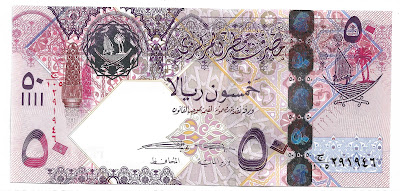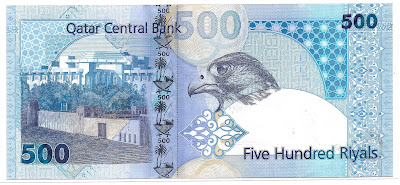1731) Banknotes of the State of Qatar: i) Brief history of the State of Qatar; ii) History of Qatari Monetary System; iii) History of Qatari Banknotes; iv) The Emblem/Coat of Arms of Qatar; v) Banknotes of the Fourth Series (2007):
i) Brief History of the State of Qatar:
The State of Qatar, is a country located in Western Asia, occupying the small Qatar Peninsula on the northeastern coast of the Arabian Peninsula with a population of less than 400,000 nationals.
Its sole land border is with neighbouring Gulf Cooperation Council (GCC) monarchy Saudi Arabia to the south, with the rest of its territory surrounded by the Persian Gulf. The Gulf of Bahrain, an inlet of the Persian Gulf, separates Qatar from nearby Bahrain.
Qatar has a high-income economy, backed by the world's third-largest natural gas reserves and oil reserves.
Qatar has been ruled by the House of Thani since Mohammed bin Thani signed a treaty with the British in 1868 that recognised its separate status.
Following Ottoman rule, Qatar became a British Protectorate in the early 20th century until gaining its independence in 1971.
In 2003, the constitution was overwhelmingly approved in a referendum, with almost 98% in favour.
In the 21st Century, Qatar has emerged as a significant power in the Arab world.
ii) Monetary System in Qatar:
Historical Background:
Prior to 1966, currencies in circulation in Qatar were those linked to the Pound Sterling, like the Indian Rupee and Gulf Rupee. When India devalued the Rupee (including the Gulf Rupee) by approximately 35%, Qatar and Dubai decided to replace the Gulf Rupee with the Saudi Riyal as an interim measure until the issuance of a new currency.
On 21.03.1966, Qatar and Dubai signed a currency agreement to set up the Qatar-Dubai Currency Board.
On 18.09.1966, the new board issued the first national currency, known as the Qatar-Dubai Riyal (QDR).
On 02.12.1971, Dubai became a part of the UAE. Therefore, it was decided to relinquish the Qatar Dubai Currency Board in accordance with Amiri Decree No. 6 of May 1973.
On 13.05.1973, Law No. 7 of 1973 was issued, establishing the Qatar Monetary Agency (QMA) to assume the duties of a Central Bank.
Further Amiri Decree—No. 24 of 1973—was issued authorizing the redemption of QDR and the issuance of a new currency known as the Qatari Riyal (QR), with the same par value against gold as the QDR.
Established in 08/1993, the Qatar Central Bank (QCB) has inherited the QMA functions.
iii) History Of Qatari Banknotes:
Before 1959, due to the strategic location of Arab Gulf region, the development of economic relations and the flourishing of commercial activity between Gulf countries and many countries, the region witnessed the circulation of a number of currencies.
The Ottoman Majidi Riyal, French Silver Riyal (Maria Theresa Riyal), Golden Pound Sterling and Indian Silver and Copper Rupees all were traded, which strengthened the trade relations between Qatar and the exporting countries.
In 1959, the Government of India, in agreement with the Gulf Countries, issued a special currency for circulation in the Arab Gulf region called the Gulf Rupee.
This currency in its gold content was equal to the Indian rupee circulating in India, but the Gulf Rupee was different in shape as it was marked by the letter (Z) in English language, and was issued in four denominations:
(One Rupee, Five Rupees, Ten Rupees, One Hundred Rupees)
Despite the fact that the Gulf Rupee had the same trading price against the pound sterling as the Indian rupee, it was not a legal currency that could be traded in India, which raised the disappointment of Gulf merchants resulting in the Gulf Rupee was phased out.
In 09/1966, Qatar decided to form a Currency Council of Qatar and Dubai, which was assigned with the task of issuing a new currency called Qatar-Dubai Riyal, which entered into circulation.
The circulation of Qatari and Dubai Riyals continued until the establishment of United Arab Emirates and the accession of Dubai to it, as it issued a new currency for it called the UAE Dirham in 1973, which led to the liquidation of Qatar and Dubai Monetary Council and the transfer of its assets and liabilities to Qatar Monetary Agency.
On 19.06.1973, for the first time a Qatari currency, the unit of which was the Qatari Riyal at that time was issued.
Established in 08/1993, the Qatar Central Bank (QCB) has inherited the QMA functions.
The Banknote Series/Denominations issued at various points of time:
The First Issue (1973): 1 Riyal, 5 Riyals, 10 Riyals, 50 Riyals, 100 Riyals, 500 Riyals.
The Second Issue (1983): 1 Riyal, 5 Riyals, 10 Riyals, 50 Riyals, 100 Riyals, 500 Riyals.
The Third Issue (1996): 1 Riyal, 5 Riyals, 10 Riyals, 50 Riyals, 100 Riyals, 500 Riyals.
The Fourth Issue (A) (2003): 1 Riyal, 5 Riyals, 10 Riyals, 50 Riyals, 100 Riyals, 500 Riyals.
The Fourth Issue (B) (2007): where the transparent window was added on two categories (100 and 500) Riyals, as well as special specifications for the visually impaired and the blind on the rest of the other categories.
The Fifth Issue (12/2020): The currency was been completely changed in design and a new denomination of 200 Riyals added.
The Front of all the Banknotes share a common design based on traditional geometric patterns, the Coat of Arms of Qatar, Qatari Flora and a gate representing historic Qatari architecture.
iv) About the Coat of Arms of Qatar:
The Front of the 50 Riyals Banknote.
16) New Circulation coins Series, Kenya: introduced by the Central Bank of Kenya on 11.12.2018
17) Sudan: A 100 Pounds Banknote being issued by the Central Bank of Sudan by End February 2019
18) Algeria: i) Introduction of two new denominations of 500 and 1,000 Algerian Dinars (AD), which will kick-start the new "Fifth Series of Algerian Dinar Banknotes" ii) A 100 Algerian Dinar tri-metallic coin which wil replace the 100 Dinar circulating Banknote of the same denomination
19) South Africa: "The Big Five Silver Coin Series": 1) First Coin in the Series brought out by the South African Mint features the African Elephant on a Five Rand Coin as the first variant issued in 02/2019: 2) Later Coin issues will feature the Lion, Leopard, Rhinoceros and the Buffalo
20) 25 Years of Constitutional Democracy in South africa (SA25): Celebrating the milestone with the issue of six circulation coins (R2 five coins & R5 one Coin) and three Commemorative Coins (Gold R500, Sterling Silver R50 & Bronze Alloy R50) issued by the South African Reserve Bank (SARB) in partnership with the South African Mint: Coin release dats: 04/2019 & 05/2019
21) Dr. Tawhida Ben Chiekh (1910-2010), Tunisia: A new 10 Dinar Banknote issued by the "Banque Centrale de Tunisie" (Central Bank of Tunisia) honouring the pioneering doctor, who replaces Dido (Queen Elissa), the founder & first Queen of Carthage on the 10 Dinar Banknote: Date of Banknote issue: 27.03.2020
19) Modern Jewish Art Mandalas, Israel: Stamps issued by Israel Postal Company (Israel Post) on three Blessings - Kingship (2.50 NIS), Remembrances (7.40 NIS), Shofar (8.30 NIS): Date of Stamp set issue: 08.09.2020
Gates of Jerusalem Coin Series:
1) "Jaffa Gate, Jerusalem", Israel: First Coin in the "Gates of Jerusalem" Coin Series: Gold & Silver Bullion Coins issued by the Israel Coins and Medals Corporation (ICMC) and minted by the Holy Land Mint in 2017:
3) "Damascus Gate", Jerusalem, Israel: Third Coin in the "Gates of Jerusalem" Coin Series: Gold and Silver Bullion Coins issued by the Israel Coins and Medals Corporation (ICMC) and minted by the Holy Land Mint in 2018 (with the year of issue as 2019):
4) "New Gate", Jerusalem, Israel: Fourth Coin in the "Gates of Jerusalem" Coin Series: Gold and Silver Bullion Coins issued by the Isral Coins and Medals Corporation (ICMC) and minted by the Holy Land Mint in 2019
5) "Golden Gate", Jerusalem, Israel: Fifth Coin in the "Gates of Jerusalem" Coin Series: Gold and Silver Bullion Coins issued by the Israel Coins and Medals Corporation (ICMC) and minted by the Holy Land Mint in 2019
"Views of Jerusalem" Gold and Silver Bullion Coin Series:
2) The City of David: Fourth Coin in the Gold and Silver Bullion Coin Series issued by ICMC, Israel & the Holy Land Mint, Israel (2019)
3) The Western Wall, Israel: Sixth Coin in the "Views of Jerusalem" Coin Series: Gold and Silver Bullion Coins minted by the Israel Coins & Medals Corporation (ICMC) Ltd: Year of Coins issue: 2020
"Ancient Cities of the Holy Land Gold and Silver Bullion Coin Series":
1) Old Jaffa, Israel: The "Ancient Cities of the Holy Land" Gold & Silver Bullion Coin Series minted by the Israel Coinsand Medals Corporation (ICMC) through the Holy Land Mint: Date of issue: 01.03.2020








No comments:
Post a Comment